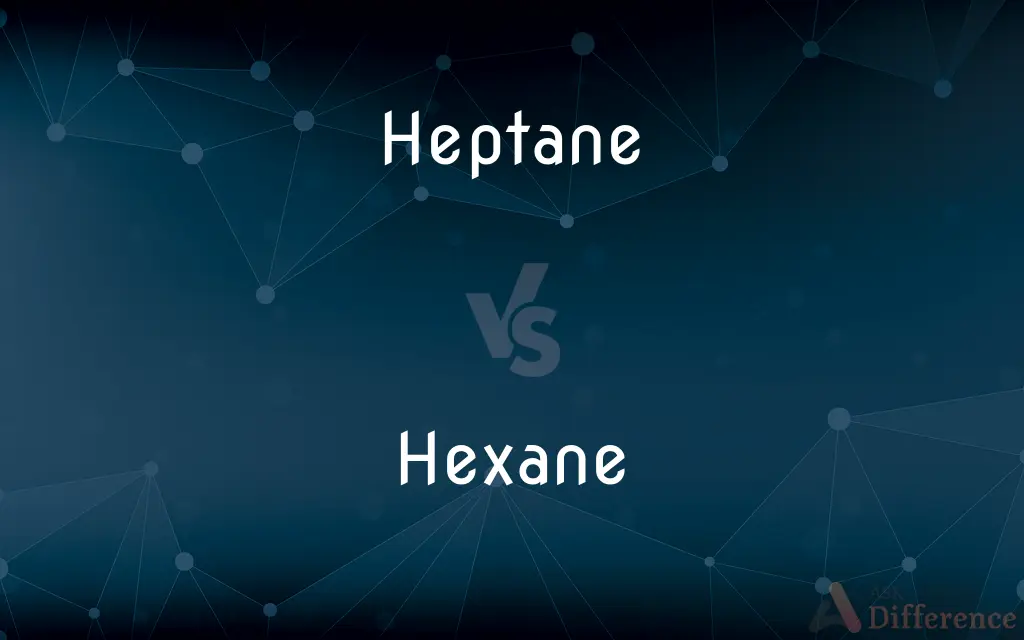Heptane vs. Hexane — What's the Difference?
Edited by Tayyaba Rehman — By Urooj Arif — Updated on March 15, 2024
Heptane is a hydrocarbon with 7 carbon atoms, known for its use in fuel and solvents, whereas hexane has 6 carbons, primarily used in extraction processes.

Difference Between Heptane and Hexane
Table of Contents
ADVERTISEMENT
Key Differences
Heptane, a straight-chain alkane with seven carbon atoms, serves various purposes in laboratories and industry, especially as a nonpolar solvent. Whereas hexane, with six carbon atoms, is most noted for its role in the extraction of oils and fats due to its excellent solvency properties.
Heptane boasts a slightly higher boiling point than hexane, which influences its volatility and evaporation rate. This characteristic makes heptane a better choice in applications where a slower evaporation rate is beneficial. On the other hand, hexane's lower boiling point makes it more volatile and efficient for quick extraction processes.
In terms of energy content, heptane contains more energy per mole due to its longer carbon chain, making it slightly more efficient as a fuel component. Hexane, on the other hand, while also used as a fuel component, offers slightly less energy content which reflects its shorter molecular structure.
Heptane is often used in the calibration of thermometers and in scientific research due to its defined boiling point. Hexane, meanwhile, is widely utilized in the pharmaceutical and food industries for extracting oils from seeds and vegetables, showcasing its importance in industrial applications.
Regarding safety and health effects, both heptane and hexane are considered hazardous and can affect the nervous system if inhaled in large quantities. However, hexane is particularly noted for its neurotoxicity, especially in industrial settings, necessitating stricter safety measures compared to heptane.
ADVERTISEMENT
Comparison Chart
Number of Carbon Atoms
7
6
Boiling Point
Higher (98.4°C)
Lower (68.7°C)
Main Uses
Solvent, fuel component, thermometer calibration
Solvent, oil extraction, cleaning agent
Energy Content
Higher
Lower
Safety and Health Effects
Hazardous, less neurotoxic than hexane
Hazardous, more neurotoxic
Compare with Definitions
Heptane
Used in the calibration of thermometers due to its precise boiling point.
Heptane's boiling point makes it a standard in scientific research for temperature measurement.
Hexane
A hydrocarbon with the formula C6H14, also part of the alkane series.
Hexane is widely used for extracting vegetable oils from seeds.
Heptane
A hydrocarbon with the formula C7H16, part of the alkane series.
Heptane is used as a reference standard in fuel octane ratings.
Hexane
Has a boiling point of 68.7°C.
Hexane's volatility requires careful handling and storage conditions.
Heptane
Often employed as a solvent and in organic synthesis.
Heptane's low polarity makes it ideal for extracting non-polar compounds.
Hexane
Utilized in adhesives, varnishes, and inks due to its solvent properties.
Hexane's ability to dissolve a wide range of substances makes it a key ingredient in many industrial processes.
Heptane
Has a boiling point of 98.4°C.
Heptane is liquid at room temperature but evaporates when exposed to air.
Hexane
Noted for its neurotoxic effects, especially in industrial settings.
Prolonged exposure to hexane can cause nerve damage and other health issues.
Heptane
Considered less neurotoxic than hexane but still requires careful handling.
Heptane exposure can lead to respiratory issues if not handled with proper protective equipment.
Hexane
Primarily used in the extraction of oils and fats, as well as a cleaning agent.
Hexane's effectiveness in oil extraction makes it valuable in the food industry.
Heptane
Heptane or n-heptane is the straight-chain alkane with the chemical formula H3C(CH2)5CH3 or C7H16, and is one of the main components of gasoline (petrol). When used as a test fuel component in anti-knock test engines, a 100% heptane fuel is the zero point of the octane rating scale (the 100 point is 100% iso-octane).
Hexane
Hexane () is an organic compound, a straight-chain alkane with six carbon atoms and has the molecular formula C6H14. Hexane is a significant constituent of gasoline.
Heptane
Any of several isomeric, volatile, colorless, highly flammable liquid hydrocarbons, C7H16, obtained in the fractional distillation of petroleum and used as solvents. The straight-chain isomer is also used as a standard in determining octane ratings and as an anesthetic.
Hexane
A colourless liquid hydrocarbon of the alkane series, present in petroleum spirit.
Heptane
(organic compound) Any of the nine isomers of the saturated aliphatic hydrocarbon C7H16, obtained from petroleum, especially n-heptane (CH3(CH2)5CH3)
Hexane
Any of several isomeric colorless flammable liquid hydrocarbons, C6H14, derived from the fractional distillation of petroleum and used as a solvent and as a working fluid in low-temperature thermometers.
Heptane
Any one of several isometric hydrocarbons, C7H16, of the paraffin series (nine are possible, four are known); - so called because the molecule has seven carbon atoms. Specifically, a colorless liquid, found as a constituent of petroleum, in the tar oil of cannel coal, etc.
Hexane
(organic compound) Any of five isomeric aliphatic hydrocarbons, C6H14. They are colorless, volatile liquids.
Heptane
A colorless volatile highly flammable liquid obtained from petroleum and used as an anesthetic or a solvent or in determining octane ratings
Hexane
Any one of five hydrocarbons, C6H14, of the paraffin series. They are colorless, volatile liquids, and are so called because the molecule has six carbon atoms.
Hexane
A colorless flammable liquid alkane derived from petroleum and used as a solvent
Common Curiosities
Can both heptane and hexane be used as solvents?
Yes, both are used as solvents, but their applications vary due to differences in volatility and solvency properties.
What is heptane mainly used for?
Heptane is used as a solvent, in fuel formulations, and for thermometer calibration due to its defined boiling point.
How does hexane's use differ from heptane?
Hexane is primarily used for extracting oils and fats from seeds and vegetables, reflecting its role in the food and pharmaceutical industries.
Why is heptane considered less neurotoxic than hexane?
Heptane is structurally different and generally causes less severe neurological effects compared to hexane, which is known for its neurotoxicity.
Are there specific safety measures for handling hexane?
Due to its neurotoxic effects, handling hexane requires strict safety measures, including proper ventilation and protective equipment.
Can heptane and hexane affect human health?
Both can affect the nervous system if inhaled in large quantities, with hexane being particularly noted for its neurotoxic effects.
What industries rely heavily on hexane?
The food, pharmaceutical, and manufacturing industries use hexane extensively for oil extraction and as a cleaning agent.
Is heptane more efficient as a fuel than hexane?
Yes, heptane has a higher energy content per mole, making it slightly more efficient as a fuel component than hexane.
How does the boiling point affect the use of heptane and hexane?
Heptane's higher boiling point reduces its volatility, making it suitable for applications requiring a slower evaporation rate, while hexane's lower boiling point makes it ideal for quick extraction processes.
Are heptane and hexane found naturally?
Both are found in crude oil and natural gas, highlighting their origins in natural hydrocarbon mixtures.
How do heptane and hexane impact the environment?
If not properly managed, both can contribute to air and water pollution, underscoring the need for careful handling and disposal.
What role does hexane play in industrial cleaning?
Hexane's solvent properties make it effective in removing oils and greases, thus being used in industrial cleaning and degreasing processes.
Why is hexane used in food processing?
Hexane efficiently extracts oils from seeds and vegetables, making it valuable in producing vegetable oils and ingredients.
What precautions are necessary when working with heptane?
Precautions include using in well-ventilated areas, wearing protective gear, and avoiding prolonged inhalation.
Does the number of carbon atoms affect the properties of heptane and hexane?
Yes, the number of carbon atoms directly influences their physical and chemical properties, such as boiling points and energy content.
Share Your Discovery

Previous Comparison
Excerpt vs. Extract
Next Comparison
Shoe vs. SandalAuthor Spotlight
Written by
Urooj ArifUrooj is a skilled content writer at Ask Difference, known for her exceptional ability to simplify complex topics into engaging and informative content. With a passion for research and a flair for clear, concise writing, she consistently delivers articles that resonate with our diverse audience.
Edited by
Tayyaba RehmanTayyaba Rehman is a distinguished writer, currently serving as a primary contributor to askdifference.com. As a researcher in semantics and etymology, Tayyaba's passion for the complexity of languages and their distinctions has found a perfect home on the platform. Tayyaba delves into the intricacies of language, distinguishing between commonly confused words and phrases, thereby providing clarity for readers worldwide.














































